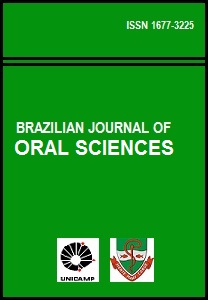Abstract
Temporomandibular disorder (TMD) is characterized by several signs and symptoms, such as pain and changes in the activation pattern of the masticatory muscles. Thus, the objective of this study was to evaluate the effect of transcutaneous electrical nerve stimulation (TENS) of the electromyographic pattern of the masticatory muscles in individuals with myogenic TMD. This study evaluated 40 female volunteers: 20 with myogenic TMD (x=23.04 ± 3.5) and 20 normal individuals (x=23.3 ± 3). TENS (conventional mode, 150Hz) was applied once to each group for 45 minutes. The electromyographic (EMG) signal (gain of 100 times and 1KHz sampling frequency) and visual analogue scale (VAS) were applied before and immediately after TENS application. The VAS data were analyzed using paired t-test. The EMG signals were analyzed using the normalized linear envelopes. The results showed that individuals with TMD have an alteration in the activation pattern of the masticatory muscles, when compared to the control group, and the TENS reversed this pattern. TENS reduced the pain intensity in the TDM group. We conclude that a single TENS application is effective in pain reduction and promotes betterments in the activation pattern of the masticatory muscles in individuals with TMD.References
Bérzin F. Estudo eletromiográfico da hiperatividade de músculos mastigatórios, em pacientes portadores de desordem crânio mandibular (DCM), com dor miofacial. In: Anais do 4º Simpósio Brasileiro e Encontro Internacional sobre Dor; 1999 jun 10-13. São Paulo; 1999. p.405.
Rodrigues D. Efeito da estimulação elétrica nervosa transcutânea na atividade elétrica do M. masseter e da porção anterior do M. temporal em indivíduos portadores de desordem craniomandibular – análise eletromiográfica [dissertation]. São Carlos: UFSC; 2000.
Cram JR, Engstrom D. Patterns of neuromuscular activity in pain and nonpain patients. Clin Biofeed Health. 1986; 9:106- 15.
Dahlström L. Electromyographic studies of craniomandibular disorderes: a review of the literature. J Oral Rehabil. 1989; 16: 1-20.
Moller E, Sheikholeslam A, Lous I. Response of elevator activity during mastication to treatment of functional disorders. Scand J Dent Res. 1984; 92: 64-83.
Stohler CS, Ashton-Miller JA, Carlson DS. The effects of pain from the mandibular joint and muscles on mastigatory motor behaviour in man. Arch Oral Biol. 1988; 33: 175-82.
Biasotto DA. Estudo da eficácia da técnica fisioterápica (massoterapia) em indivíduos portadores de DTM miogênica, frendor através da eletromiografia pré e pós-tratamento [thesis]. Piracicaba: FOP/UNICAMP; 2002.
Kamyszek G., Ketcham R, Garcia RJr, Radke J. Electromyographic evidence of reduced muscle activity when ULF-TENS is applied to the Vth and VIIth cranial nerves. Cranio. 2001; 19:162-8.
Schwartz G, Lund JP. The effects of noxious stimulation on masticatory movements in the rabbit. J Dent Res. 1992; 71(Spec.Issue): 743.
Travell J, Rinzler S, Herman M. Pain and disability of the sholder and arm. Treatmente by intramuscular infiltration with procaine hydrochloride. J Am Med Assoc. 1942; 120: 417-22.
Lund JP, Donga R, Widmer CG, Stohler CS. The pain-adaptation model: A discussion of the relationship between chronic musculoskeletal pain and motor activity. Can J Physiol Pharmacol. 1991; 69: 683-94.
Lamp J, Dunn B. Symmetrical biphasic TENS waveform for treatment of back pain. Clin J Pain. 1987; 3: 145-51.
Fried T, Johnson R, Mccracken W. Transcutaneous electrical nerve stimulation: its role in the control of chronic pain. Arch Phys Med Rehabil. 1984; 65: 228-31.
Deyo RA, Walsh NE, Schoenfeld LS, Ramamurthy S. Can trials of physical treatments be blinded? Am J Phys Med Rehabil. 1990; 69: 6-10.
Graff-Radford SB, Reeves JL, Baker RL, Chiu D. Effects of transcutanous electrical nerve stimulation on myofascial pain and trigger point sensitivity. Pain. 1989; 37: 1-5.
Lundeberg T. A comparative study of pain alleviating effect of vibratory stimulation, transcutaneous electrical nerve stimulation, eletroacupunture and placebo. Am J Clin Med. 1984; 12: 72-9.
Francini F. Maresca M, Procacci P, Zoppi M. The effects of non-painful transcutaneous electrical nerve stimulation on cutaneous pain threshold and muscular reflexes in normal men and in subjects with chronic pain. Pain. 1981; 11: 49-63.
Robinson AJ. Transcutaneous electrical nerve stimulation for the control of pain in musculoskeletal disorders. J Orthop Sports Phys Ther. 1996; 24: 208-26.
Melzack R, Wall P. Pain mechanisms: new Theory. Science. 1965; 150: 971-9.
Salar G, Job I, Mingrino S, Bosio A. Trabucchi M. Effect of transcutaneous electrotherapy on CSF:â-endorphin content in patients without pain problems. Pain. 1981; 10: 169-72.
The Brazilian Journal of Oral Sciences uses the Creative Commons license (CC), thus preserving the integrity of the articles in an open access environment.

